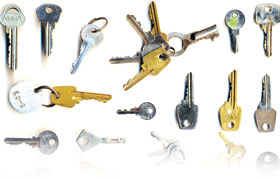

Key control and asset management technology is a reliable and cost effective method to improve security by ensuring that facility keys are properly managed with regard to access, storage and tracking. Key management systems can reinforce access control policies that are already in place and can also help to reduce the costs associated with lost keys or unmanaged access.

Technology inside the box
Tamper-proof systems are designed so that only authorised users – using pre-programmed PIN codes, access cards or biometrics – can access keys, while on-board advanced technology automatically records all access activity.
A basic system typically consists of a computerised key storage cabinet, a key locking mechanism and a tracking system. From this basic package, several options and design variations can be added to customise the solution and help protect the investment as needs grow and change. For networked installations, management software can also be included in the system. Permission levels can be established for each user and data can be monitored from any desktop connected to the network. Additionally, the software can run activity reports, sort based on different criteria and view and print reports, among other uses.
Today’s key control and management systems have become a higher level management tool for effectively addressing the safety and security of building occupants and the security of the building assets. Knowing the identity of authorised key holders, which keys they have in their possession or have access to and when they were used are all essential pieces of information needed to help ensure a safe and secure environment. Further, technological developments and open protocols have made it possible to integrate key control with access control and other security systems as part of a facility’s networked security system. Now, a user who has taken a specific key can be denied egress from the facility until the key is returned – and selected management can be alerted via email if a key has not been returned on time.
Easy implementation
Implementing a key control and management system is a straightforward process that involves a few basic steps: take inventory of the facility to identify all access points and installed locks; ascertain the operational needs of employees as well as of others who may need access to the facility (e.g., service repair or cleaning crew); and establish a policy with easy to follow procedures for effective key control and management.
Having the ability to add on the exact components you need, or change modules where and when you need, helps protect your investment. This way you will avoid having to rip and replace an entire key control and asset management system because the current system cannot accommodate lockers for securing cell phones or other valuable items, or does not integrate with a new access control system that’s just been installed.
If a networked key control system is planned, a review of the network topology will reveal any configuration and performance alterations that may need to be applied. Compatibility with other security systems should also be reviewed to maximise interoperability for more comprehensive integrated operations.
A simple but strong set of guidelines for administration and use of the key control system will help to define areas of responsibility and enable better control of the keys.
Setting up your system
Configuring a key control solution is as easy as identifying needs and then building the system with modular components that meet those needs. Choices for modules may include key storage modules, lockers, credit card modules or simply blank modules (to be filled at a later time). The combination of modules is entirely up to the user, providing the ability to customise and also change the system to meet growth or other specific needs.
Key control and asset management systems can also be configured with additional security features to help enhance the integrity of the system. For example, where protection of asset lockers itself is mission-critical, installation of a remote access device provides an additional layer of protection by enabling the locker system to be placed in a secure room. A second individual’s PIN input and verification are then required in order for an authorised employee to access the contents of a locker.
Access to the key and asset cabinets can also be customised, with options including a built-in keypad, biometrics such as a fingerprint reader and a magnetic or proximity card reader. Systems that integrate card readers for access can often utilise the access control cards that are already in use throughout the organisation, making the system implementation easier and more convenient. Changes to an individual’s access authorisation can be made instantly by program administrators. The optional user interfaces can be integrated directly into the cabinet for easy accessibility or they may be separate. In either design, users can access only the stored items that they have been authorised to remove or return.
Integration potential
A key control and asset management solution can usually be integrated with the existing physical security system without costly upgrades or overhauls. For example, asset control systems featuring alarm and relay inputs/outputs can be integrated with existing video surveillance systems for additional security measures. Ethernet and USB capability help to ensure system compatibility and integration. Key management systems can also integrate with a facility’s existing identification cards.
The compatibility with other security systems and network access offer an added richness and usability and integration with existing data bases saves time and money. Ethernet or TCP/IP communications ports allow ease of use for direct connectivity to printers or other devices, or networked connectivity via Ethernet.
Management software tracks and analyses
One of the enabling factors for successful key control implementation is the ability to manage all programming, remote functions and reports for the system with a software-driven solution. Similar in concept to popular access control systems, the PC-based package of key management software helps make day-to-day operations and activities easier and more fluid. Users can be added from a global list and all specific settings (added or modified) will be automatically synchronised across the system. Profiles can be assigned for improved user control, and administrative access levels have various options to be tailored to specific needs such as reports only or alarms only.
Built-in schedulers can be programmed to automatically download all data to a secure PC as required by the user. With this capability, management can better sort and analyse information to maintain maximum control of access and security issues.
Scheduled email reports, detailing what keys are in or out and who has/had them, keeps security management informed and up to date. If an incident occurs, management can query the system for specific details. Together with the audit data from an access control system, a key control system’s reporting system provides a strong evidence trail.
Key control goes mobile
Advanced communication capabilities also enable key control systems to be monitored and administered remotely from PDAs or smartphones as well as from the desktop. Authorised personnel can check key status, cancel an alarm, and even remotely disable user access. These features, along with multiple others, provide the mobile user with another level of convenience and control when it comes to key control management.
For more information, contact Morse Watchmans, +1 203 264 4949, morse@morsewatchman.com, www.morsewatchmans.com

© Technews Publishing (Pty) Ltd. | All Rights Reserved.